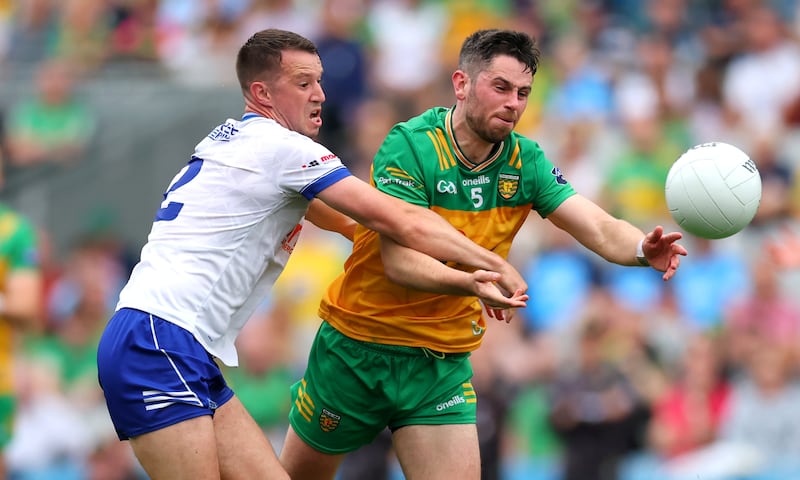Like many people, I was a little sceptical about how the Football Review Committee (FRC) amendments would play out when under the spotlight of championship football. Had we overdone this change? Would managers, coaches and tacticians find a way to get around the best intentions of Jim Gavin and his committee?
I was dubious about the two-pointer but it’s added a lot to the excitement of the game and hasn’t had the effect of turning games into trimmings, as was feared.
My view is still that we should stop allowing two points from frees that are brought back outside the arc because with so many footballers able to kick 45s, it’s too easy. Fine if someone is fouling outside the 40 metres to prevent a two-pointer but, for frees within the arc, one point should be enough.
Assessing the football from the early stages of the provincial championships up to next week’s All-Ireland semi-finals, I’m looking at an unrecognisable game. Football has been utterly transformed in how it is played and how teams are approaching it.
The game is now a brilliant watch. Most weekends, this column has been focused on how good the games have been. Now that the fixtures have moved to Croke Park, the standard has gone up another notch. We have the best teams playing in the best venue.
Only the weekend before last, we had four quarter-finals, and all – well, certainly three – were really absorbing in their own way. The FRC deserves huge credit for this. It’s not perfect and there have been tweaks as the year has gone on but even that has been a breath of fresh air.
Bringing rules in and making changes and then dropping them again – if that’s what the evidence supports – has really helped to keep the game on the right path. Imagine if the FRC had needed to go back to congress with motions for every idea they wanted to try out and remove. The process would have been endless.
Instead, good ideas stick and even if it has been at times disruptive, players and referees have just got on with it. When special congress meets in October to debate final acceptance, the picture will definitely be a whole lot brighter than it was.
It was part of the FRC mission to make football the most enjoyable amateur game to watch and also to play. That’s another box ticked. As a retired county player with a bad hip, I can confirm that the three-up rule is a godsend. There were years playing in the full forwards when you had a corner back running up the field in the opposite direction and you trying to tag him. That day is done. If he wants to go, good luck to him. I’ll stand at the halfway line and watch, waiting for him to come back.
[ Tweaks by FRC to rules are minimalist, but likely to have a major impactOpens in new window ]
Football has simply become a more enjoyable game.
It is also a different game. Kick-outs now are going long, and we saw last week in the first quarter-final how Monaghan completely obliterated Donegal’s restarts in the first half and vice versa in the second half.
If you’re not winning your own kick-out, chances are that you’re out of shape. For instance, everybody could be spread out trying to get into a position where they can create space for a catch for either themselves or somebody else. In doing that, the defence is left wide open, and if you don’t win possession, the penalties are very, very severe, as we saw in both the Donegal-Monaghan quarter-final and Kerry-Armagh the next day.
You can really go after a team on their kick-out now, and as an inside forward you’re now standing on the edge of the D with ball flying out over your head. You’re thinking: “I’m on here when it comes back so time to get myself into position.”

In the past, as an inside forward, you were reacting to short kick-outs and having to track the man on the ball and run up the field after him. Within 10 seconds, you’re in your own full back line and the shape and the structure of the team is completely distorted.
It’s a big change and I would say clubs are maybe still only getting used to it at this stage, particularly those who haven’t had access to their county players until the past couple of weeks.
[ FRC propose adjustment to 50m penalty for foul on player catching kick-out markOpens in new window ]
There are now more one-on-one contests. Look at Jordan Morris against Galway in their quarter-final. When did we last see a corner forward get in that sort of space and have that sort of freedom to play? Or get those opportunities to win the ball in front of the defender and take him on?
The change has also encouraged some really good individual defensive performances recently: Jack Coyne in a few matches for Mayo; Davy Byrne for Dublin against Tyrone; Seán Rafferty for Meath.
Ryan Wylie has been exceptional defensively for Monaghan all year and he’s a footballer who has been playing in defensive systems and structures for a long time. It would have been very easy for him to say, “Oh, this doesn’t suit me,” but he’s had one of his best years.
We are also seeing the difference that Croke Park makes. There is no such thing as a bad bounce. The game is that wee bit crisper and sharper. Warm air and new balls – there are always new footballs for matches there – come into play as well, so the playing conditions are perfect for the best players to thrive. We caught a glimpse of that with Kerry kicking two-pointers against Armagh. They hadn’t been that bothered with them until then but with everything facilitating quality kickers, they picked them off all afternoon.
You know exactly where the ball is going to go.
The big dilemma for players with a hard surface such as Croke Park is usually what studs to wear. Again, as a general rule, backs tend to prefer studs because they can’t afford to slip whereas forwards choose firm-ground boots. When it’s wet, though, there are problems.
I saw Graham O’Sullivan slip twice in the first half of Kerry-Armagh and I was wondering did he change at half-time. Tom Lahiff came on for Dublin and the ball was played towards him. It was a fairly vital ball at the time, but there was no pressure on him and he was going to win it. Next thing he slipped and ends up touching the ball on the ground: a significant momentum swing from small details.
But small details are likely to make a big difference over the final two weeks of the season.


















